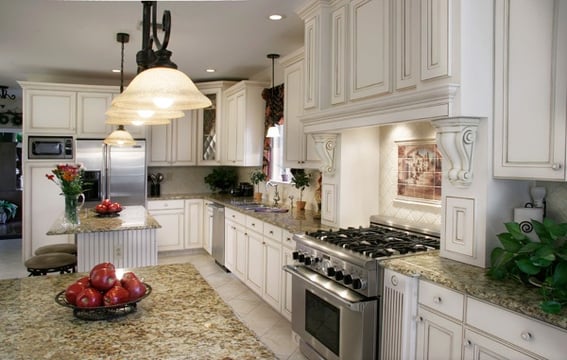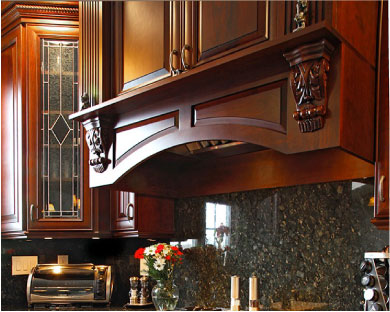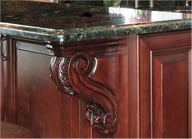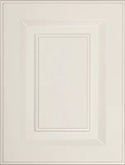In past posts, we discussed several types of kitchen molding that serve both decorative and practical purposes, such as light rails, full and split posts and cabinet fluting.

What are Corbels?
 It's best to first describe what they are not:
It's best to first describe what they are not:
Although you can find corbels decorated with three or more vertical lines associated with traditional fluted surfaces, corbels in general are not cabinet fluting. You might hear them described as such, but they only fulfill that definition when they're the fluted type.
Corbels are architectural elements found in historical and modern buildings around the world. Traditionally, they support and decorate a variety of objects including shelves, counters, tabletops, doorways, roofs and gutters.
Corbels are similar to upside-down L-shaped metal brackets. Unlike and L-shaped bracket though, each corbel has a solid, three-dimensional traingular shape.
If you look at a corbel from the side, the back is designed to be mounted to a wall or cabinet and the top to serve as a rest for objects. The front and sides are plain, or carved/molded with some combination of decorative embellishments: fruits, vines, flowers, feathers, scallops, animals, geometric shapes, scroll work, rosettes or, of course, fluted lines.
Traditional corbels were created from wood, metal, stone or plaster. Modern corbels are still made from these materials, as well as synthetic materials like resins and polyurethane.
Why You Should Want One...
Actually, you should want two corbels. They look best displayed in pairs.
Whether your kitchen is modern, rustic or on the plain side, and regardless of the size of the corbels, you should want them because:

-
Ornate corbels add an elegant, luxurious or whimsical touch to shelves, single pedestal and multi-leg tables, countertop extensions, doorway and window frame corners and crown molding ends.
-
Standalone corbels on walls that display plates or artwork are great conversation pieces.
-
A row of corbels under a long shelf, counter or hamtle - a corbel table - can tell a story through different designs.
-
Thin or wide corbels with smooth sides and curves, or geometric patterns, make interesting modern kitchen accessories.
-
Corbels create the imprssion of Greek and Roman architecture and a sense of tradition in kitchens with Mediterranean or classic Italian themes.
-
In country kitchens, corbels marked with symbols from nature bring the outdoors indoors and make spaces feel more rustic and cozy.
-
Light or dark corbels embellished with plant motifs in cool-colored kitchens invoke warm and pleasant feelings.









